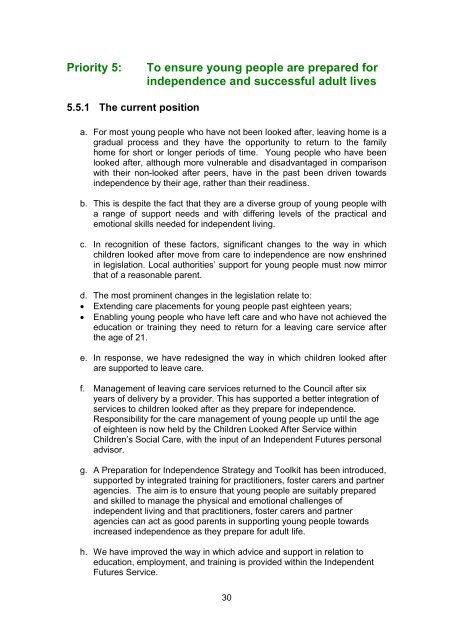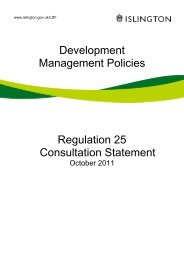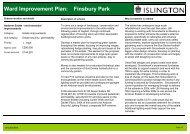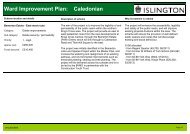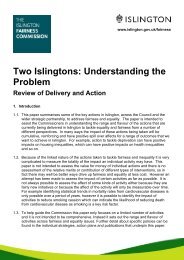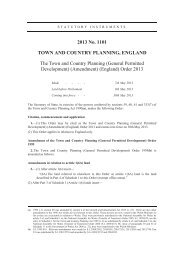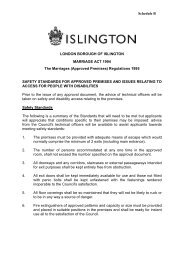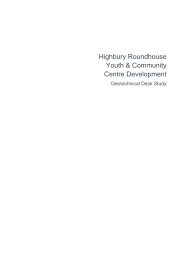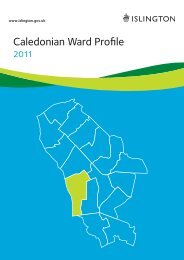The Islington Plan for Looked After Children and ... - Islington Council
The Islington Plan for Looked After Children and ... - Islington Council
The Islington Plan for Looked After Children and ... - Islington Council
You also want an ePaper? Increase the reach of your titles
YUMPU automatically turns print PDFs into web optimized ePapers that Google loves.
Priority 5:<br />
To ensure young people are prepared <strong>for</strong><br />
independence <strong>and</strong> successful adult lives<br />
5.5.1 <strong>The</strong> current position<br />
a. For most young people who have not been looked after, leaving home is a<br />
gradual process <strong>and</strong> they have the opportunity to return to the family<br />
home <strong>for</strong> short or longer periods of time. Young people who have been<br />
looked after, although more vulnerable <strong>and</strong> disadvantaged in comparison<br />
with their non-looked after peers, have in the past been driven towards<br />
independence by their age, rather than their readiness.<br />
b. This is despite the fact that they are a diverse group of young people with<br />
a range of support needs <strong>and</strong> with differing levels of the practical <strong>and</strong><br />
emotional skills needed <strong>for</strong> independent living.<br />
c. In recognition of these factors, significant changes to the way in which<br />
children looked after move from care to independence are now enshrined<br />
in legislation. Local authorities’ support <strong>for</strong> young people must now mirror<br />
that of a reasonable parent.<br />
d. <strong>The</strong> most prominent changes in the legislation relate to:<br />
Extending care placements <strong>for</strong> young people past eighteen years;<br />
Enabling young people who have left care <strong>and</strong> who have not achieved the<br />
education or training they need to return <strong>for</strong> a leaving care service after<br />
the age of 21.<br />
e. In response, we have redesigned the way in which children looked after<br />
are supported to leave care.<br />
f. Management of leaving care services returned to the <strong>Council</strong> after six<br />
years of delivery by a provider. This has supported a better integration of<br />
services to children looked after as they prepare <strong>for</strong> independence.<br />
Responsibility <strong>for</strong> the care management of young people up until the age<br />
of eighteen is now held by the <strong>Children</strong> <strong>Looked</strong> <strong>After</strong> Service within<br />
<strong>Children</strong>’s Social Care, with the input of an Independent Futures personal<br />
advisor.<br />
g. A Preparation <strong>for</strong> Independence Strategy <strong>and</strong> Toolkit has been introduced,<br />
supported by integrated training <strong>for</strong> practitioners, foster carers <strong>and</strong> partner<br />
agencies. <strong>The</strong> aim is to ensure that young people are suitably prepared<br />
<strong>and</strong> skilled to manage the physical <strong>and</strong> emotional challenges of<br />
independent living <strong>and</strong> that practitioners, foster carers <strong>and</strong> partner<br />
agencies can act as good parents in supporting young people towards<br />
increased independence as they prepare <strong>for</strong> adult life.<br />
h. We have improved the way in which advice <strong>and</strong> support in relation to<br />
education, employment, <strong>and</strong> training is provided within the Independent<br />
Futures Service.<br />
30


